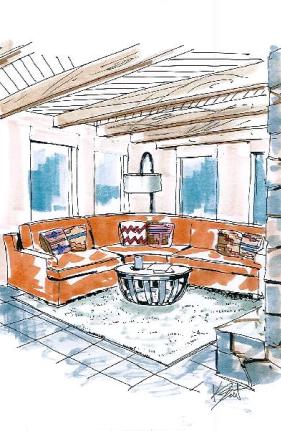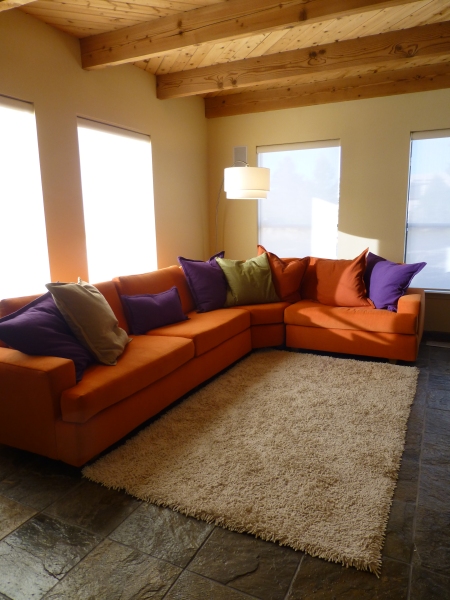An article from the Washington Post came across my desk a couple of weeks ago by Bonnie McCarthy “E-decorators” draw cost-conscious clients. In this article she identifies what she calls the “modern trappings of online interior designers – designers who by her estimation are “renovating the process of how style comes home.” 
In this writing she interviews interior designers about their various methods of providing services to their clients and certainly the newer way is more virtual than hands-on in-person. But think about it – designers have always had to deal with virtual conditions. Working from plans is just that!
With the new generation of consumers – millennials and those to follow – computers are an appendage. Everything is referenced or accessed via a computer, tablet or smart phone. So it’s natural for them to utilize these tools for design inspiration or consultation. The article however is noting this new approach for everyone who expects a designer to be an expensive on-site investment.
Throughout the article it references the “new” e-design approach as a now more cost-effective, affordable exchange with interior designers. I think that sounds like a gimmick. The time spent is the time spent – the ideas provided are just that and the fees are the fees. Now, if these e-designers or unlicensed decorators are lowering their fees – well then that’s part of the story. However, I do not get the feeling that they are. Rather, I get the feeling that they are merely marketing to a broader audience than those found in their immediate physical locations. Smart. There’s another part of the story. Selling the idea that this is cost-effective over having to meet live with a designer and thereby getting those customers and also broadening the reach to those potential clients is a gimmick that seems to be working.
The fact that the article suggests that this new “e-design” consultation is more cost-effective than live and in-person versions of the same is interesting. Maybe it is – maybe not. It would save transportation time for the designer and they might pass that savings on to their clients – or they might just have higher fees and more profit for their time involved. Difficult to know – hourly consultation rates vary according to location and market price.
For the designers or firms that have established a formula and template for their clients, this seems fairly efficient. On-line information forms quiz clients on their likes and dislikes, personality and requirements. However,this can also be can occur on a local level at the outset of an in-person consultation. The combination of digital communication and in-person, on-site design consults might just be the best process. A client’s form might even be filled out in advance of the first meeting via email to give the designer an intro to the project. Digital images of the space in question can be uploaded for the designer to review, evaluate, and critique. What once was the method of clients snipping magazine articles and photos for review and discussion, sites like Pinterest allow for a place where designer and client can “pin” their ideas for visual communication and discussion.
So is it the cost? Is it the seeming efficiency? Is it the working at your own convenience after hours? What makes the e-design attractive? Why is it better than having a designer come to your residence and discuss on-site with images and tangible samples what you want and the designer recommends?
Tangible samples…I don’t even like or trust what I see on-line regarding fabrics and carpets – anything textile for sure is impossible on a monitor. Tangible samples that you can touch and feel, press and fold, rub and caress are invaluable features of the selection process. Therefore, the sensory deprivation of e-design is one negative. Yes, samples can be mailed – but there is a lag-time there too.
The myriad choices made available online now for home decor shopping has opened up the entire world of possibilities for the consumer. But that same client exposed to these limitless wonders of the world cannot cull their finds with confidence to bring together a cohesive design. In this design process, some things have to be forfeited and others embraced and incorporated. It’s all about making the right decisions. The designer aids in and facilitates making those right decisions and bringing in even more ideas to the project with their expertise and experience.
With thorough websites, designers can present their work and potential clients can research until they find one that they think meets their expectations. Once that has been established, the client can even interview a few designers to make sure that the in-person chemistry is there between them. Or…there’s face-time!!
So back to the e-design. It’s not new – the methods are – but design across the miles has been going on for decades. Plans mailed, faxed and now digitally shot over the globe. Prior to a building being built – it is a virtual place designed diagrammatically, built in models, illustrated, and sketched – by hand or CAD it only exists in the mind’s eye of the designers and those to whom they are conveying these concepts. 
 Selecting the interior furnishings and finishes for these edifices has always been similarly virtual. Until something is built and furnishing installed, the designs are all “virtual.”
Selecting the interior furnishings and finishes for these edifices has always been similarly virtual. Until something is built and furnishing installed, the designs are all “virtual.”
So “e-design” is on another plane of communication with the client with new tools to facilitate and communicate. But the advantages or lack thereof are many and seem to be more applicable to a client in a remote location without benefit of good local designers.
I knew an incredibly creative and adventurous couple who, back in the 60s and 70s, established a private resort on an island where everything was selected and obtained via mail-order catalogs, shipped across the water, received in docks, transported to local delivery vessels and dropped on a beach weeks later. Not so different today for those located far from the modern conveniences but connected now to the world via the internet, fast jets of Federal Express, DHL, UPS and all the trucks, sea trains and land rails that move goods around the world. That’s when this instantaneous assistance for decision-making with a designer over the miles can be extremely advantageous – you have no other means of getting together and the framework is in place to do it all remotely.
So if you fancy the idea of having an LA designer consult for your condo in Dupont Circle or a Denver designer make their recommendations for you in Boston, so be it. Yet, I say investigate your local interior designers, visit their websites, contact their references, and see how their fees and talents compare between each other, and then compare to them to the e-offerings on-line and go with what works best for you!


